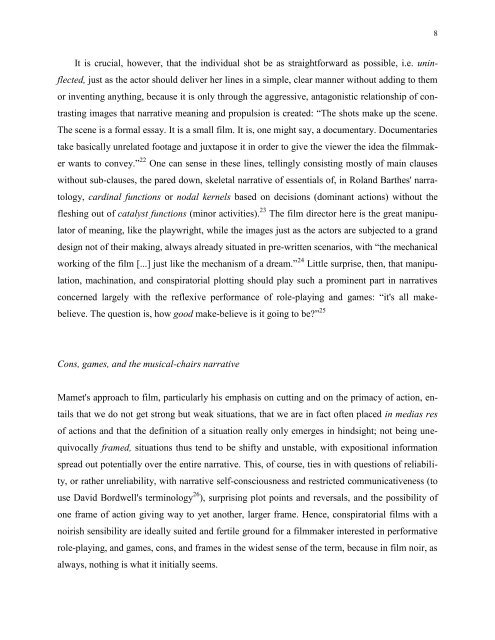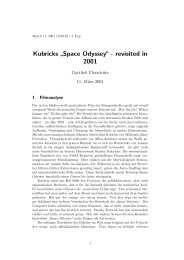Henry M. Taylor, 'Frames, Cons, and Double-Crosses - Cinetext
Henry M. Taylor, 'Frames, Cons, and Double-Crosses - Cinetext
Henry M. Taylor, 'Frames, Cons, and Double-Crosses - Cinetext
You also want an ePaper? Increase the reach of your titles
YUMPU automatically turns print PDFs into web optimized ePapers that Google loves.
It is crucial, however, that the individual shot be as straightforward as possible, i.e. unin-<br />
flected, just as the actor should deliver her lines in a simple, clear manner without adding to them<br />
or inventing anything, because it is only through the aggressive, antagonistic relationship of con-<br />
trasting images that narrative meaning <strong>and</strong> propulsion is created: ―The shots make up the scene.<br />
The scene is a formal essay. It is a small film. It is, one might say, a documentary. Documentaries<br />
take basically unrelated footage <strong>and</strong> juxtapose it in order to give the viewer the idea the filmmak-<br />
er wants to convey.‖ 22 One can sense in these lines, tellingly consisting mostly of main clauses<br />
without sub-clauses, the pared down, skeletal narrative of essentials of, in Rol<strong>and</strong> Barthes' narra-<br />
tology, cardinal functions or nodal kernels based on decisions (dominant actions) without the<br />
fleshing out of catalyst functions (minor activities). 23 The film director here is the great manipu-<br />
lator of meaning, like the playwright, while the images just as the actors are subjected to a gr<strong>and</strong><br />
design not of their making, always already situated in pre-written scenarios, with ―the mechanical<br />
working of the film [...] just like the mechanism of a dream.‖ 24 Little surprise, then, that manipu-<br />
lation, machination, <strong>and</strong> conspiratorial plotting should play such a prominent part in narratives<br />
concerned largely with the reflexive performance of role-playing <strong>and</strong> games: ―it's all make-<br />
believe. The question is, how good make-believe is it going to be?‖ 25<br />
<strong>Cons</strong>, games, <strong>and</strong> the musical-chairs narrative<br />
Mamet's approach to film, particularly his emphasis on cutting <strong>and</strong> on the primacy of action, en-<br />
tails that we do not get strong but weak situations, that we are in fact often placed in medias res<br />
of actions <strong>and</strong> that the definition of a situation really only emerges in hindsight; not being une-<br />
quivocally framed, situations thus tend to be shifty <strong>and</strong> unstable, with expositional information<br />
spread out potentially over the entire narrative. This, of course, ties in with questions of reliabili-<br />
ty, or rather unreliability, with narrative self-consciousness <strong>and</strong> restricted communicativeness (to<br />
use David Bordwell's terminology 26 ), surprising plot points <strong>and</strong> reversals, <strong>and</strong> the possibility of<br />
one frame of action giving way to yet another, larger frame. Hence, conspiratorial films with a<br />
noirish sensibility are ideally suited <strong>and</strong> fertile ground for a filmmaker interested in performative<br />
role-playing, <strong>and</strong> games, cons, <strong>and</strong> frames in the widest sense of the term, because in film noir, as<br />
always, nothing is what it initially seems.<br />
8



